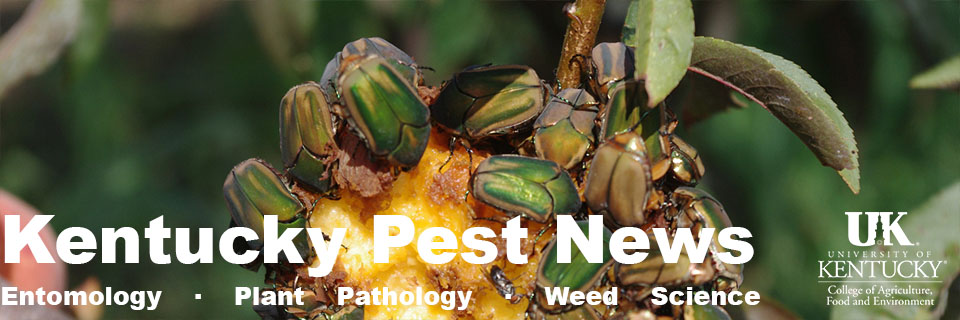Reports of powdery mildew have increased rapidly in cucurbit crops in the past 2 weeks. Powdery mildew is a common disease of all cucurbits that usually appears first near the middle of the growing season. The disease occurs in greenhouses…
Monthly Archives: July 2017
Lawn Ants
Several species of ants are common landscape residents. They nest in places that meet their needs: suitable soil type and drainage, convenient food sources, and in some cases, sheltering rocks or logs. We most commonly share greenspace with field ants,…
Plant Disease Diagnostic Lab Highlights
The following plant disease highlights from the University of Kentucky Plant Disease Diagnostic Laboratories represent recent sample submissions from field crops, fruit, vegetables, and ornamentals. Diagnostic samples of agronomic crops from the past week have included summer black stem on…
2017 Insect Trap Counts
Trap counts for major insect pests are provided by the Kentucky IPM Program. Traps are located at the UK Research and Education Center in western Kentucky and the UK Spindletop Farm in Lexington. Below are trap counts for the current…
Welcome Dr. Kiersten Wise to the University of Kentucky
Dr. Kiersten Wise is the Department of Plant Pathology’s newest addition to the faculty (Figure. 1). She is an Extension Plant Pathologist with responsibilities in field crops and is based out of the University of Kentucky Research and Education Center…
Southern Rust of Corn Confirmed in Kentucky
Southern rust of corn, caused by the fungus Puccinia polysora, was confirmed by the University of Kentucky Plant Disease Diagnostic Laboratory (PDDL) this week on samples from Caldwell County and Graves County. This is the first confirmation of southern rust…
Monitor Bt Sweet Corn for Corn Earworm
Corn earworm, Heliocoverpa zea (Boddie), is the key insect pest in Kentucky attacking the kernels on tips of corn ears (Figure 1). Even low levels of infestation can be problematic since damage is concealed until the husk leaves are removed…
Downy Mildew of Grape
Downy mildew is an important disease of commercial and backyard grapes in Kentucky. Current warm, wet, humid weather conditions favor infection and disease development. When flowers, clusters, and shoots become infected by downy mildew, yield losses result. This disease may…
Spotted Wing Drosophila Update
Spotted wing drosophila (SWD) is active across the state and has been detected at all of our cooperating field sites. Moderate to high levels of SWD are being trapped around the state as can be seen from the map (Figure…
Dogwood Sawflies
As with many plant-feeding insects, the dogwood sawfly is one of those pests that rarely draws much attention but occasionally can be very destructive. A report of damage early this week provides a good opportunity to review this interesting and…
Japanese Beetles Aren’t Finished
Japanese beetle activity in some parts of Kentucky this year have resembled scenes from the 1980s when this insect rolled across the state (Figure 1). Although the peak of adult feeding has passed for 2017, the last of the adults…
Turf-cruising Green June Beetles and Bluewinged Wasps
Green June beetles (Figure 1) and bluewinged wasps (Figure 2) are beginning to cruise turf areas now. Green June beetle grubs feed on organic matter in the soil. These grubs do not feed on plant roots, but they can uproot…
Cicada Killer Wasps
Large, but mild-mannered, female cicada killer wasps (Figure 1) are buzzing across Kentucky intent on: Digging underground burrows and Provisioning themselves with paralyzed cicadas that will be food for their grub-like larvae. The wasps will focus on these tasks over…
Lone Star “Seed Ticks” Can Ruin a Good Summer Day
Tiny lone star tick larvae (“seed ticks”) will be active over the next few weeks (Figure 1). Reaction to their bites cause painful itching that can last for 7 to 20 days. Dressing appropriately, using repellents, and checking regularly for…
Plant Disease Diagnostic Lab Highlights
The following plant disease highlights from the University of Kentucky Plant Disease Diagnostic Laboratories represent recent sample submissions from field crops, fruit, vegetables, and ornamentals. Diagnostic samples of agronomic crops from the past week have included common rust, southern rust,…
